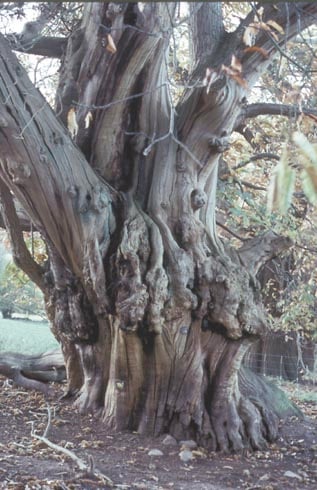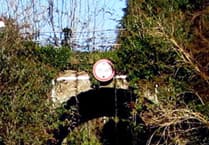In the peaceful churchyard at Linton, three miles east of Ross, grows a striking tree. Hollow, gnarled, dying back and propped up it looks more like some ancient weathered sculpture than a tree and it is one of the great treasures of our district.
The tree is a yew and though damaged by fire should last for many years yet. According to a survey done 15 years ago by Ian Standing it is, at over 32 feet or 10 metres in girth, the largest tree in our area.
With an estimated age of 4,000 years the tree is not only far older than the beautiful Norman church by whose walls it stands but is twice the age of Christianity itself. Locally other notable churchyard yews can be seen at Lea, Hewelsfield and Awre. No-one knows why churches were built close to these ancient trees but it has been suggested that the Christian churches supplanted earlier pagan holy sites.
Considering Dean's ancient status as Britain's 'premier oak forest,' we have surprisingly few really old trees here. Such trees are of irreplaceable value. They provide a stable habitat for specialised fungi, insects, spiders, mosses and lichens as well as homes for animals and nesting birds. But they are also important in the landscape and for their social and historical associations which is why many of them have their own names such as the Domesday Oak at Ashton Court near Bristol.
Sadly the Newland oak is long gone but there are still some notable oaks in the Dean. Churchill Enclosure has one of the country's many Charles oaks. Not far away in Russell's Enclosure one of a group of oaks called the Three Brothers still stands. This group of three trees grew within a few metres of each other and were a well known landmark. It is said that when mine-owners refused to allow union gatherings at the pits miners used to meet at Three Brothers to discuss union matters.
Sweet chestnuts grow more quickly than oaks and imposing chestnuts with their distinctive fissured, twisting bark can sometimes be seen amongst oaks planted early in the 19th century. There is a good example at the side of Marsh Lane in Ellwood. Beeches, with a smooth bark that has always attracted name carvers, also grow quickly and some, such as those on Welshbury Hill, may not be quite as old as they look.
However there are some truly aged chestnut hulks to be seen. Alongside the public footpath skirting Highnam Pinetum is a monster coppiced chestnut with several stems each of which would make a massive tree in itself. At the other side of the district at Bigsweir two lines of chestnuts run up the hillside behind Bigsweir House. This group of trees which can be seen from the public footpath are probably the most important stand of veteran trees in the Dean. Like the Linton yew the Bigsweir chestnuts have massive, calloused boles. They look to be dying on their feet but trees take a long time to fail and decay. Most of these trees will see us out comfortably.
Elsewhere in the Wye Valley if you go and walk the woodlands you come across wonderful, old time pollards. There is a notable one in a hedgerow at Newland near where the Newland Oak used to stand. Another graces the edge of a wood near the peregrine nesting cliff at Coldwell Rocks and more are scattered about the Woodland Trust's woods between Redbrook and Bigsweir. Mapping these great lime pollards would make a fascinating study.
And we need to know the location of these trees. They are as much a part of our heritage as historic buildings and they deserve equal respect and protection. A register of veteran trees was recommended in the Gloucestershire biodiversity plan and it would be good to see the county council taking this forward.
It is obvious that if one of these venerable trees dies or is destroyed it takes centuries to replace it so every last one is important. As Oliver Rackham wrote, 'Ten thousand oaks of 100 years old are not a substitute for one 500 year-old oak.'




